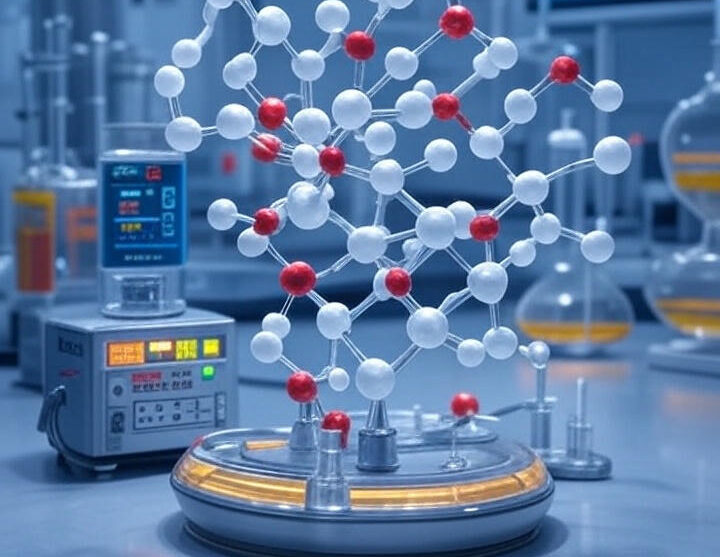Kinetics of Chemical Reactions: Fundamentals, Experimental Analysis, Reactor Design, and Future Prospects
Chemical kinetics, the study of reaction rates and mechanisms, is a cornerstone of physical chemistry with profound implications for industrial processes, environmental sustainability, and biomedical advancements. By analyzing how quickly reactions occur and the pathways they follow, chemical kinetics enables the optimization of chemical systems, from pharmaceutical synthesis to renewable energy production. This expanded article delves into the principles of elementary and non-elementary reactions, methods for determining reaction order and rate constants, batch reactor design, and explores cutting-edge research and future prospects in greater detail.
1. Fundamentals of Chemical Kinetics
Chemical kinetics quantifies the speed of chemical reactions and the factors influencing them, such as concentration, temperature, and catalysts. The reaction rate is defined as the change in concentration of a reactant or product over time:
where \([A]\) is the reactant concentration, \([P]\) is the product concentration, and \(t\) is time. The negative sign for reactants reflects their consumption.
1.1 Elementary and Non-Elementary Reactions
Elementary Reactions
Elementary reactions occur in a single molecular event, with the reaction stoichiometry matching the molecularity (number of colliding molecules). These reactions are characterized by their simplicity and direct rate laws.
- Unimolecular: A single molecule rearranges or decomposes, e.g., \(A \to P\). Example: Radioactive decay of uranium-238.
- Bimolecular: Two molecules collide, e.g., \(A + B \to P\). Example: \(2NO + O_2 \to 2NO_2\).
- Termolecular: Three molecules collide (rare due to low probability), e.g., \(2NO + Cl_2 \to 2NOCl\).
The rate law for elementary reactions directly reflects the molecularity, with the rate constant \(k\) dependent on temperature and activation energy.
Non-Elementary Reactions
Non-elementary reactions involve multiple elementary steps, forming intermediates that do not appear in the overall stoichiometry. The rate law is not directly deducible from the stoichiometry and must be determined experimentally. For example, the decomposition of ozone (\(2O_3 \to 3O_2\)) proceeds through multiple steps, and its rate law might be:
Key approaches to analyze non-elementary reactions include:
- Rate-Determining Step: The slowest step governs the overall rate.
- Steady-State Approximation: Assumes that the concentration of intermediates remains constant, simplifying rate law derivation.
- Pre-Equilibrium: Assumes fast equilibrium steps precede a slow step.
1.2 Factors Influencing Reaction Rates
Several factors affect reaction rates, each rooted in the collision theory or transition state theory:
- Concentration: Higher concentrations increase collision frequency, as reflected in the rate law.
- Temperature: The Arrhenius equation quantifies the temperature dependence of the rate constant:
- Catalysts: Lower \(E_a\), increasing the rate without being consumed.
- Pressure: For gas-phase reactions, higher pressure increases concentration, enhancing the rate.
- Surface Area: In heterogeneous catalysis, larger surface areas increase reaction sites.
- Solvent Effects: Solvent polarity can stabilize or destabilize transition states, affecting rates.
where \(A\) is the pre-exponential factor, \(E_a\) is the activation energy, \(R\) is the gas constant (8.314 J/mol·K), and \(T\) is the absolute temperature.
2. Determining Order and Rate Constant from Experimental Data
The rate law for a reaction is typically:
where \(m\) and \(n\) are the partial orders, and \(m + n\) is the overall order. These parameters are determined experimentally using several methods.
2.1 Initial Rate Method
This method measures the initial rate (\(r_0\)) at various initial concentrations (\([A]_0, [B]_0\)) while keeping one reactant constant. For example:
Taking the logarithm:
By varying \([A]_0\) and keeping \([B]_0\) constant, a plot of \(\ln r_0\) vs. \(\ln [A]_0\) yields a slope of \(m\). Similarly, \(n\) is determined. The rate constant \(k\) is then calculated by substituting \(m\) and \(n\) into the rate law.
2.2 Integrated Rate Laws
Integrated rate laws relate concentration to time, allowing order determination by fitting data to the appropriate equation:
- Zero-Order: \( r = k \)
- First-Order: \( r = k[A] \)
- Second-Order: \( r = k[A]^2 \)
Plot \([A]\) vs. \(t\); a linear plot indicates zero-order, with slope \(-k\).
Plot \(\ln [A]\) vs. \(t\); a linear plot indicates first-order, with slope \(-k\).
Plot \(\frac{1}{[A]}\) vs. \(t\); a linear plot indicates second-order, with slope \(k\).
For complex reactions, fractional or negative orders may arise, requiring numerical fitting.
2.3 Half-Life Method
The half-life (\(t_{1/2}\)) is the time for \([A]\) to decrease to \([A]_0/2\):
- Zero-Order: \( t_{1/2} = \frac{[A]_0}{2k} \)
- First-Order: \( t_{1/2} = \frac{\ln 2}{k} \approx \frac{0.693}{k} \) (independent of \([A]_0\))
- Second-Order: \( t_{1/2} = \frac{1}{k [A]_0} \)
By measuring \(t_{1/2}\) at different \([A]_0\), the order can be inferred from the dependence.
2.4 Differential Method
Plot \(\ln r\) vs. \(\ln [A]\) using rate and concentration data at various times. The slope gives the order \(m\), and the intercept helps calculate \(k\).
2.5 Advanced Techniques
- Stopped-Flow Spectroscopy: Measures rapid reactions by mixing reactants and monitoring concentration changes in milliseconds.
- Temperature-Jump Methods: Perturbs equilibrium to study relaxation kinetics, useful for fast reactions.
- Isotope Effects: Using isotopic substitution (e.g., deuterium) to probe mechanisms by comparing rate constants.
3. Design of Batch Reactors
Batch reactors are closed systems where reactants are loaded, react, and products are removed after completion. They are ideal for small-scale, high-value products like pharmaceuticals and specialty chemicals.
3.1 Basic Design Equation
For a constant-volume batch reactor, the material balance for reactant \(A\) is:
Integrating gives the reaction time:
For specific rate laws:
- First-Order (\( r_A = k[A] \)):
- Second-Order (\( r_A = k[A]^2 \)):
3.2 Design Parameters
- Reactor Volume: Determined by initial moles (\(N_{A0}\)) and concentration:
- Temperature Control: The energy balance accounts for heat effects:
- Mixing: Agitation ensures uniform concentration and temperature, modeled by impeller Reynolds number and power input.
- Material Selection: Reactors use materials like stainless steel or glass-lined steel to resist corrosion and high pressures.
- Safety: Pressure relief systems and inert gas blanketing prevent explosions or runaway reactions.
where \(\Delta H_r\) is the heat of reaction, \(Q\) is the heat transfer rate, \(N\) is total moles, and \(C_p\) is the heat capacity. Cooling jackets or coils manage exothermic reactions, while heaters support endothermic ones.
3.3 Optimization
- Conversion: Higher conversion requires longer times, balanced against cost.
- Selectivity: For parallel reactions (e.g., \(A \to P\), \(A \to Q\)), conditions like temperature or catalysts enhance desired products.
- Cycle Time: Includes reaction, heating/cooling, and cleaning, optimized using kinetic models.
- Scale-Up: Lab-scale data is scaled to industrial reactors, considering mixing and heat transfer limitations.
4. Advanced Research in Chemical Kinetics
Recent advancements in chemical kinetics are expanding its applications through experimental and computational innovations.
4.1 Computational Kinetics
- Quantum Chemistry: Density functional theory (DFT) and ab initio methods calculate potential energy surfaces, predicting \(E_a\) and \(A\). For example, DFT studies of CO oxidation on metal catalysts reveal active sites.
- Molecular Dynamics: Simulates molecular collisions and transition states, e.g., modeling methane combustion:
- Machine Learning: Neural networks predict rate constants and mechanisms from experimental data, reducing reliance on trial-and-error experiments. Recent studies (2024) use graph neural networks to model complex catalytic cycles.
4.2 Microkinetic Modeling
Microkinetic models integrate elementary steps to predict macroscopic behavior without assuming a rate-determining step. These models use rate constants from DFT or experiments to simulate industrial processes, such as ammonia synthesis:
4.3 Single-Molecule Kinetics
Advances in single-molecule spectroscopy (e.g., fluorescence correlation spectroscopy) allow observation of individual reaction events, providing insights into heterogeneous catalysis and enzyme dynamics. Recent research (2023) on enzyme kinetics revealed conformational changes affecting rate constants.
4.4 Ultrafast Kinetics
Femtosecond laser spectroscopy studies reactions on picosecond timescales, e.g., photochemical reactions in photosynthesis. This informs the design of artificial photosynthetic systems for solar energy capture.
5. Future Prospects of Chemical Kinetics
Chemical kinetics is poised to address global challenges through interdisciplinary applications, with ongoing research shaping its future.
5.1 Sustainable Energy and Green Chemistry
- CO₂ Utilization: Kinetics optimizes catalysts for CO₂ reduction to fuels like methanol:
- Biofuel Production: Kinetic models enhance enzymatic hydrolysis of biomass and pyrolysis of lignocellulose, improving yield and efficiency.
- Hydrogen Economy: Kinetics of water splitting (\(2H_2O \to 2H_2 + O_2\)) informs electrocatalyst design for green hydrogen production.
Research (2025) focuses on Cu-based catalysts with improved selectivity.
5.2 Advanced Materials
- Nanocatalysis: Kinetic studies of nanoparticle surface reactions improve efficiency in fuel cells and hydrogen storage. Recent work (2024) on Pt nanoparticles shows size-dependent kinetics.
- Polymer Synthesis: Kinetics controls polymerization rates, enabling tailored materials like biodegradable plastics.
5.3 Environmental Applications
- Air Quality: Kinetic models of tropospheric reactions (e.g., \(NO_x + VOCs \to O_3\)) improve air pollution predictions. Research (2025) integrates satellite data with kinetic models for real-time monitoring.
- Water Treatment: Advanced oxidation processes (e.g., \(OH^\cdot\)-mediated degradation) are optimized using kinetics to remove microplastics and pharmaceuticals.
5.4 Biomedical and Pharmaceutical Applications
- Enzyme Kinetics: The Michaelis-Menten model:
- Pharmacokinetics: Models drug metabolism and clearance, supporting personalized medicine. Research (2025) explores kinetics of mRNA vaccine delivery systems.
- Synthetic Biology: Kinetic models of gene regulatory networks design synthetic organisms, e.g., bacteria producing biofuels.
guides drug design by analyzing enzyme inhibition. Recent studies (2024) use kinetics to develop inhibitors for SARS-CoV-2 proteases.
5.5 Artificial Intelligence Integration
- Automated Reaction Discovery: AI predicts reaction pathways by analyzing kinetic data, accelerating catalyst development. A 2024 study used AI to optimize Fischer-Tropsch synthesis.
- Digital Twins: Virtual reactor models integrate real-time kinetic data for process optimization, reducing energy costs in chemical plants.
5.6 Space and Extreme Environments
- Astrochemistry: Kinetics models reactions in interstellar clouds, e.g., formation of complex organic molecules. Research (2025) explores kinetics under microgravity for in-space manufacturing.
- High-Pressure Kinetics: Studies reactions in extreme conditions, like planetary interiors, informing materials for space exploration.
6. Conclusion
Chemical kinetics is a dynamic field bridging fundamental science and practical innovation. By understanding elementary and non-elementary reactions, determining rate parameters experimentally, and designing efficient batch reactors, kinetics enables precise control of chemical processes. Cutting-edge research in computational modeling, single-molecule studies, and ultrafast kinetics is expanding our understanding of reaction mechanisms. Future applications in sustainable energy, advanced materials, environmental protection, and biomedicine promise to address global challenges, making chemical kinetics a pivotal discipline for a sustainable and technologically advanced future.














